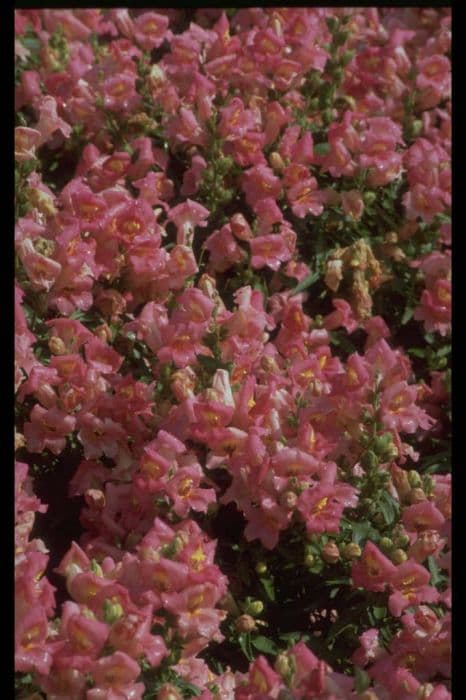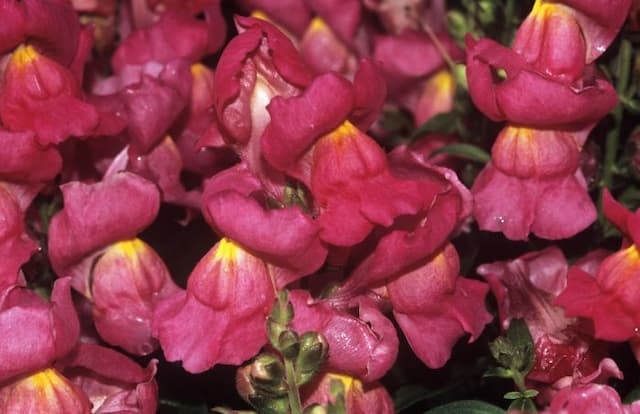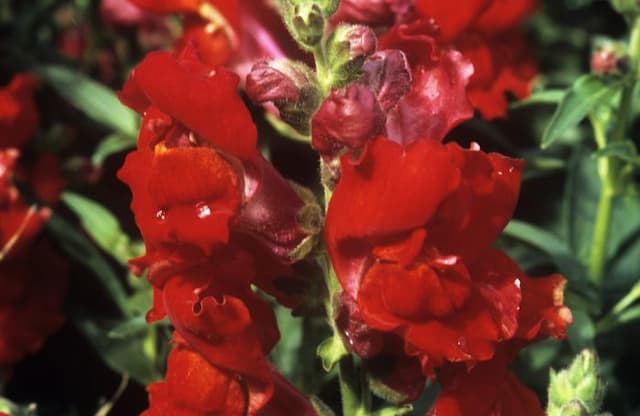Beardtongue Penstemon 'Maurice Gibbs'

ABOUT
The Penstemon 'Maurice Gibbs' is a striking ornamental plant known for its vibrant flowers and lush foliage. This perennial showcases a dense cluster of leaves that form a lush base from which tall spikes emerge. The leaves are typically glossy, elongated, and may have a fine-toothed margin, creating a backdrop that highlights the blooms. The flowers are the real standouts on this plant, arranged along the spikes in a tubular fashion reminiscent of small trumpets. Their color, a rich blend that can range from deep purples to bright pinks, draws in the eye and makes a bold statement in any garden. The blossoms have a five-lobed corolla, with a relatively broad, flaring mouth that's perfect for attracting pollinators such as bees and hummingbirds. Combining these characteristics, 'Maurice Gibbs' presents a showy appearance, with the play of colors and textures providing a spectacular visual impact that enhances the landscape throughout its flowering period.
About this plant
 Names
NamesFamily
Plantaginaceae
Synonyms
Beardtongue, Penstemon
Common names
Penstemon 'Maurice Gibbs'.
 Toxicity
ToxicityTo humans
Beardtongue is generally considered non-toxic to humans. There are no well-documented cases of poisoning from ingesting this plant, and it is not known to contain any toxic substances that would cause harm to humans upon ingestion.
To pets
Beardtongue is also generally considered non-toxic to pets. It is not known to contain any harmful substances that could lead to poisoning if pets were to ingest it. Consequently, there are no specific symptoms associated with beardtongue poisoning in pets, as it is not typically a concern for pet health.
 Characteristics
CharacteristicsLife cycle
Perennials
Foliage type
Semi-deciduous
Color of leaves
Green
Flower color
Mixed
Height
2-3 feet (60-90 cm)
Spread
1-2 feet (30-60 cm)
Plant type
Herb
Hardiness zones
Varies
Native area
North America
Benefits
 General Benefits
General Benefits- Attracts pollinators: The Penstemon 'Maurice Gibbs', commonly known as Beardtongue, is known for its tubular flowers that attract bees, butterflies, and hummingbirds which are beneficial for pollination.
- Drought tolerance: Once established, Beardtongue plants are drought-tolerant, making them suitable for xeriscaping or for gardens in arid climates.
- Low maintenance: This plant requires minimal care once established, making it ideal for gardeners looking for plants that do not require frequent watering or special treatment.
- Aesthetically pleasing: With its vibrant flowers and attractive foliage, the Beardtongue adds color and visual interest to gardens and landscapes.
- Long blooming period: Beardtongue plants often have a long flowering season, providing color and aesthetic appeal over an extended period.
- Cold hardy: Beardtongue plants can withstand cold temperatures, making them suitable for gardens in cooler climates.
- Erosion control: Their root systems can help stabilize soil and prevent erosion, especially on slopes or in areas with loose soil.
- Deer resistant: Beardtongue is not a preferred food source for deer, making it a good choice for gardens in areas where deer browsing is a problem.
- Versatility: The plant can thrive in a variety of soil types, as long as there is good drainage, and it can be used in perennial borders, rock gardens, or wildflower meadows.
- Native plant advantages: As a native species, Beardtongue is adapted to local climates and ecosystems, which can make it easier to grow and can support the local wildlife.
 Medical Properties
Medical PropertiesThis plant is not used for medical purposes.
 Air-purifying Qualities
Air-purifying QualitiesThis plant is not specifically known for air purifying qualities.
 Other Uses
Other Uses- Penstemon, including the 'Maurice Gibbs' variety, can be used in floral art and arrangements due to its bright flowers and spiky appearance, which add height and texture.
- The flowers of the Penstemon can be used for dyeing fabrics or paper, yielding various shades of colors depending on the mordants used.
- Penstemon's tube-shaped flowers are sometimes used in educational settings to teach about plant-pollinator interactions, particularly those involving bees.
- In garden design, Penstemon 'Maurice Gibbs' can be used as a living border to define spaces while providing a splash of color.
- As a companion plant in vegetable gardens, Penstemon can attract pollinators which are beneficial for crops that rely on insect pollination.
- Penstemon plants can be used in sensory gardens as they are visually striking and can stimulate interest among visitors.
- In photography, the vibrant flowers of Penstemon can be the subject of macro photography to capture their intricate details and colors.
- The Penstemon can be incorporated into wildlife gardens to provide nectar for hummingbirds and butterflies throughout the blooming period.
- Penstemon plants can be used in xeriscaping, as they are drought-tolerant once established and thus reduce the need for frequent watering.
- During festive seasons, cut flowers of Penstemon can be used as part of natural table centerpieces to create a colorful and welcoming ambiance.
Interesting Facts
 Feng Shui
Feng ShuiThe Beardtongue is not used in Feng Shui practice.
 Zodiac Sign Compitability
Zodiac Sign CompitabilityThe Beardtongue is not used in astrology practice.
 Plant Symbolism
Plant Symbolism- Resilience: Penstemons, known commonly as beardtongues, often symbolize resilience as they can thrive in tough environments and have the ability to bounce back from challenging conditions.
- Longevity: With the ability to live for several years, beardtongues represent longevity and enduring presence.
- Diversity: The wide variety of penstemons, with varying colors and forms, can be seen as a symbol of diversity and the beauty of different characteristics coming together.
- Health: Many penstemons, including the 'Maurice Gibbs' variety, are used in traditional remedies, often symbolizing health and healing.
- Attractiveness: Beardtongues are known for their attractive and vivid flowers, thus they can symbolize charm and the ability to draw in others.
 Water
WaterBeardtongue, the common name for Penstemon 'Maurice Gibbs', prefers regular watering with moderation. Aim to water the plant deeply once a week, allowing the soil to dry out slightly between waterings. Provide about one to one and a half gallons of water for each plant during each watering session, depending on the weather conditions; heat waves may require a slight increase. Over-watering can lead to rot, so ensure good drainage. During winter, reduce watering frequency as the plant goes dormant.
 Light
LightBeardtongue thrives best in full sun to partial shade. It's essential to place the plant in a location where it receives at least 6 to 8 hours of sunlight a day. However, in areas with very hot summers, some afternoon shade will help protect the plant from excessive heat.
 Temperature
TemperatureBeardtongue can tolerate a wide range of temperatures but performs best when the temperature remains between 60°F and 85°F. It can survive minimum winter temperatures down to about 20°F. Do not expose the plant to temperatures above 90°F for prolonged periods, as this may cause stress and damage.
 Pruning
PruningPruning Beardtongue promotes bushier growth and prevents the plant from becoming leggy. Prune in early spring by cutting back about one-third of the plant's height. Additionally, deadhead spent blooms regularly to encourage more flowering. The best time for more extensive pruning is right after the main flowering flush has subsided.
 Cleaning
CleaningAs needed
 Soil
SoilBeardtongue requires well-draining soil with a slightly acidic to neutral pH of 6.0 to 7.0. A mix of loam, coarse sand, and compost is ideal for this plant to thrive.
 Repotting
RepottingBeardtongue should be repotted every 2-3 years or when it outgrows its current container to refresh the soil and encourage healthy growth.
 Humidity & Misting
Humidity & MistingBeardtongue prefers moderate humidity levels but is relatively adaptable and can tolerate drier air common in most home environments.
 Suitable locations
Suitable locationsIndoor
Place in bright light, minimal watering.
Outdoor
Full sun to part shade, well-drained soil.
Hardiness zone
4-9 USDA
 Life cycle
Life cycleThe life cycle of Penstemon 'Maurice Gibbs', commonly known as Beardtongue, begins with seed germination which typically occurs in the spring if exposed to the appropriate temperature and moisture conditions. Following germination, the seedling establishes itself, growing into a juvenile plant with a rosette of leaves near the ground. As the plant matures, it develops a strong root system and erect flowering stalks during the late spring to early summer. The plant reaches full maturity when it blooms, showcasing tubular flowers that are highly attractive to pollinators such as bees and hummingbirds. Following pollination, the flowers produce small capsules containing numerous seeds that, once mature, are dispersed by wind or gravity. Beardtongue then enters a period of dormancy during the winter, with the roots surviving underground to begin the cycle again the following spring.
 Propogation
PropogationPropogation time
Spring-Early Summer
The Penstemon 'Maurice Gibbs', commonly known as Beardtongue, can be propagated most popularly by stem cuttings. Cuttings are best taken in late spring or early summer when the plant's growth is most vigorous. To propagate, cut a 3- to 6-inch section of a non-flowering stem, strip the lower leaves, and dip the cut end into rooting hormone. The stem should then be inserted into a well-draining soil mix, ensuring at least two or three nodes are buried where leaves were removed. The soil should be kept evenly moist but not saturated, and the cutting should be placed in bright, indirect light. In a few weeks, the cutting should develop roots and can be transplanted into the garden or a more permanent container.









